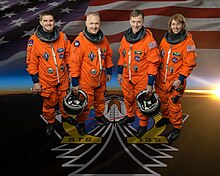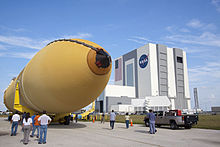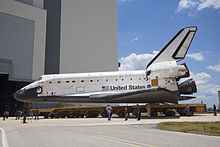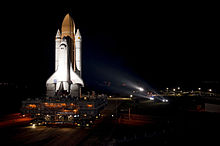STS-135
| COSPAR ID | 2011-031A |
|---|---|
| SATCAT no. | 37736 |
| End of mission | |

 | |
STS-135 (ISS assembly flight ULF7)[4] is the final planned mission of the American Space Shuttle.[5][6] It will use the hardware originally processed for the STS-335 contingency mission, as the Launch On Need (LON) rescue mission designated to support STS-134 was not ultimately needed.
Although the mission was authorized, it initially had no appropriation in the NASA budget, raising questions about whether the mission would fly at all. On 20 January 2011, program managers changed STS-335 to STS-135 on the flight manifest. This allowed for training and other mission specific preparations.[7] On 13 February 2011, program managers told their workforce that STS-135 would fly “regardless” of the funding situation via a continuing resolution.[8] Until this point, there had been no official references to the STS-135 mission in NASA official documentation for the general public.[9][10][11][12]
During an address at the Marshall Space Flight Center on 16 November 2010, NASA administrator Charles Bolden said that the agency needed to fly STS-135 to the station in 2011, due to likely delays in the development of commercial rockets and spacecraft designed to transport cargo to the ISS. "We are hoping to fly a third shuttle mission (in addition to STS-133 and STS-134) in June 2011, what everybody calls the launch-on-need mission ... and that's really needed to [buy down] the risk for the development time for commercial cargo," Bolden said.[13]
Space Shuttle Atlantis is to fly the 12-day mission. Atlantis will carry the STS-335 four-person crew (the smallest of any shuttle mission since April 1983's STS-6). The mission's primary cargo will be the Multi-Purpose Logistics Module (MPLM) Raffaello and a Lightweight Multi-Purpose Carrier (LMC). The mission is included in NASA's 2011 authorization,[14] signed into law on 11 October 2010, but funding remained dependent on a subsequent appropriation bill. United Space Alliance signed a contract extension for this mission, along with STS-134; the contract contained six one-month options with NASA in order to support continuing operations. All STS-135 crew members were custom-fitted for a Russian Sokol space suit and molded Soyuz seat liner, should they be forced to return to Earth via a Soyuz capsule in the event that the shuttle is deemed unable to make a safe reentry.[15]
The U.S. government budget approved in mid-April 2011 called for $5.5 billion for NASA's space operations division, including the space shuttle and space station programs. According to NASA, the budget running through 30 September 2011 ended all concerns about funding the STS-135 mission.[16]
Crew

NASA announced the STS-335/135 crew on 14 September 2010.[17] It will be the first time that a crew of four will fly to the International Space Station. The last shuttle mission to fly with just four crew members occurred 28 years prior to STS-135, on STS-6 on 4 April 1983 aboard Space Shuttle Challenger. Only four astronauts are assigned to the mission, versus the normal six or seven, because there no longer are any space shuttles on standby for a potential rescue. In the event of serious damage to the shuttle in orbit, the four would move into the International Space Station and return, one at a time over the course of a year, via Russian Soyuz capsules.[18] The reduced crew size also allows the mission to maximize the amount of payload carried to the ISS.[19]
| Position | Astronaut | |
|---|---|---|
| Commander | Christopher Ferguson Third spaceflight | |
| Pilot | Douglas Hurley Second spaceflight | |
| Mission Specialist 1 | Sandra Magnus Third spaceflight | |
| Mission Specialist 2 | Rex Walheim Third spaceflight | |
Authorization
With support from both the House of Representatives and the Senate, the fate of STS-135 ultimately depended on whether lawmakers could agree to fund converting the mission from launch-on-need to an actual flight.[5]
On 15 July 2010, a U.S. Senate committee passed the 2010 NASA reauthorization bill, authored by Senator Bill Nelson, to direct NASA to fly an extra space shuttle mission (STS-135) pending a review of safety concerns.[20] The bill still needed the approval of the full Senate. A draft NASA reauthorization bill considered by the House Science & Technology Committee did not provide for an extra shuttle mission.[21] On 22 July 2010 U.S. Rep. Suzanne Kosmas, during a meeting of the House Science Committee, successfully amended the House version of the bill to add an additional shuttle mission to the manifest.[22]
On 5 August 2010, the U.S. Senate passed its version of the NASA reauthorization bill just before lawmakers left for the traditional August recess.[23][24] On 20 August 2010, NASA managers approved STS-135 mission planning targeting a 28 June 2011 launch.[5] On 29 September 2010 the U.S. House approved the Senate-passed bill on a 304–118 vote.[25] The bill, approved by the U.S. Congress, went to President Barack Obama for his signature.[26]
On 11 October 2010, President Obama signed the legislation into law, allowing NASA to move forward with STS-135,[6][27] though without specific funding.
As of 20 January 2011, STS-135's designation was officially changed from STS-335.[7]
As of 14 February 2011, NASA managers announced that STS-135 will fly 'regardless' of the funding situation in Congress.[28]
Mission milestones
The mission marks:
- 166th (and the final currently planned) NASA manned space flight
- 135th shuttle mission since STS-1
- 33rd flight of Atlantis
- 3rd shuttle flight in 2011
- 37th shuttle mission to the ISS
- 110th post-Challenger mission
- 22nd post-Columbia mission
Payload
Atlantis will ferry extra supplies to the International Space Station. Since the ISS program has a strong likelihood of being extended to 2020, it is probable that the station will require more spare supplies after the shuttle retires. A shuttle extension would allow for the crew to maintain the completed space station, but an ISS extension was never intended to be a guaranteed shuttle program extension,[29] and the shuttle program is officially to end after STS-135. Therefore, the more delivery of excess supplies for the station, the better.[30]
Multi-Purpose Logistics Module
Multi-Purpose Logistics Module (MPLM) Raffaello will make up the majority of the payload. The MPLM will be filled with 16 resupply racks, which is the maximum that it can handle.
Lightweight Multi-Purpose Carrier
The Lightweight Multi-Purpose Carrier (LMC) will also be flown on this mission. The External Thermal Cooling System (ETCS) Pump Module (PM) which failed and was replaced on orbit in August 2010, is planned to have a ride home on the LMC so that a failure analysis can be performed on the ground. It has not been determined what, if anything, will ride up to the station on the LMC.[5]
Robotic Refueling Mission
Atlantis will carry the Robotic Refueling Mission (RRM) developed by the Satellite Servicing Capabilities project at the Goddard Space Flight Center (GSFC). It plans to demonstrate the technology and tools to refuel satellites in orbit by robotic means.[31] After the proof of concept, the long-term goal of NASA is to transfer the technology to the commercial sector.[31]
RRM will include four tools, each of these incorporating electronics and two cameras and lights. Additionally it will have pumps and controllers and electrical systems such as electrical valves and sensors.[32]
The RRM payload was transported to the Kennedy Space Center in early March, 2011 where the GSFC team will perform the final preparations for space flight. Once up in the International Space Station, RRM will be installed into the ELC-4. The Dextre robot will be used during the refueling demonstration.
TriDAR
Atlantis will also carry the TriDAR, developed by Neptec as a test flight during rendezvous, docking, undocking, and flyaround. TriDAR is a laser-based relative navigation vision system that does not rely on cooperative targets found on the target spacecraft. As the system was designed for for robotic refueling and the servicing of satellites, which may not have any cooperative targets attached, it instead tracks the geometry of the target spacecraft. This will be the third test flight of TriDAR, which was also tested aboard Discovery during STS-128 and STS-131.
Down-mass payload
The failed ammonia pump module that was replaced in August 2010 is expected to be returned inside Atlantis' payload bay. Also, a problematic Common Cabin Air Assembly (CCAA) Heat Exchanger (HX) is expected to be returned inside the MPLM.
-
Raffaello in the Space Station Processing Facility.
-
Robotic Refueling Mission during pre-launch preparations.
Shuttle processing


ET-138 was produced at the Michoud Assembly Facility (MAF) in New Orleans and arrived at the Kennedy Space Center on the Pegasus barge.[33] After offloading, the tank was transported into a checkout cell inside the VAB on 14 July 2010.
NASA initially planned for STS-134 (Endeavour) to fly with the newer ET-138 and for the LON STS-335 (Atlantis) mission to utilize the refurbished ET-122 only in the event that a rescue of Endeavour's crew were required. During Hurricane Katrina, ET-122 was damaged at the Michoud Assembly Facility (MAF) in New Orleans and while the tank was certified as completely flight-worthy after its repairs were completed, NASA management ruled that ET-122 posed a slightly higher risk of losing foam from the repaired areas and therefore assigned it to the STS-335 mission that would likely never fly. However, once it was decided to fly Atlantis on a full STS-135 mission, the tank assignments were swapped so that in the event STS-134 (Endeavour) were to suffer damage from ET-122, Atlantis with the newer and less risky ET-138 would be poised to rescue Endeavour's crew.[34]
Early December 2010, ground technicians installed the main engines on Atlantis. The Shuttle received the center engine on 7 December 2010, followed by the lower-right engine and the lower-left on 8 and 9 December 2010 respectively inside Orbiter Processing Facility (OPF-1). The event marked the last set of main engines ever to be installed on a space shuttle.[35]
Stacking operations of the Solid Rocket Boosters (SRBs) for the mission commenced in the evening hours of 29 March 2011.[36] Technicians inside the VAB, lifted the left-aft segment from the handling crate and carefully maneuvered into High Bay No. 1 and finally onto the mobile launch platform. The booster stacking was completed in mid April. The completed boosters had a mixture of refurbished and unflown elements (11 sections on each booster). For example, the forward dome for the right-hand booster is new, while the upper cylinder on the left booster flew with STS-1 – the historic maiden flight of Space Shuttle Columbia.[37] (For detailed information on the STS-135 boosters, see[38])
After completing the assembly process, the External Tank-138 was mated to the SRBs on 25 April.
First family visit
President Barack Obama, First Lady Michelle Obama, and their daughters Malia Obama and Sasha Obama viewed Atlantis at the Orbiter Processing Facility (OPF-1) on their visit to the Kennedy Space Center on 29 April 2011.[39] The first family missed the launch of Endeavour on the STS-134 mission, as the launch was scrubbed due to problems with two heaters on one of Endeavour's auxiliary power units (APUs).
During their tour of the Orbiter Processing Facility, the first family was accompanied by United Space Alliance tile technician Terry White and astronaut Janet Kavandi. Standing under the wings of space shuttle Atlantis, White gave the president and his family an informal tutorial.[40]
Rollover

On the early morning of 17 May 2011, Space Shuttle Atlantis departed OPF-1 and headed to the VAB for mating operations with ET-138.[41] The short trip took longer than normal and allowed the shuttle workers to pose for a photo opportunity with the shuttle. The four STS-135 astronauts were also present to greet the workers and representatives of the media.[42][43] Atlantis remained on the Orbiter Transport System overnight, as opposed to heading over to High Bay 1 on the same day.
Inside the VAB transfer aisle, lifting operations to rotate Atlantis vertically commenced on 18 May 2011. The crane that hoisted the shuttle placed it into the adjacent high bay. Atlantis was next lowered to meet up with the external tank and the two solid rocket boosters. The mating operations were completed on 19 May 2011. On the same day, NASA officially announced 8 July 2011 as the intended launch date of the STS-135 mission.
Rollout
Atlantis was rolled out to Launch Pad 39A on 1st June.[44] The first motion of Atlantis out of the Vehicle Assembly Building began at 8:42 p.m. EDT on May 31. Due to a minor hydraulic leak on a corner valve for the jacking and elevation system on the crawler-transporter, the move was delayed by 40 minutes.[45] After the 3.4-mile journey, the shuttle was secured on the launch pad at 3:29 a.m. EDT on 1 June 2011.[46]
Large crowds, including the families of NASA's workforce, were present during the rollout. The STS-135 crew was also at the Kennedy Space Center to witness the last-ever rollout of a Space Shuttle. The crew participated in an informal Question & Answer session with news media, which was aired live on NASA TV. While Atlantis was rolled out to the launch pad, Endeavour was landing a few miles away at the Shuttle Landing Facility, touching down on Kennedy Space Center's Runway 15 at 2:34 a.m. EDT after completing its final mission, STS-134.
-
President Obama and his family view Atlantis at OPF-1.
-
Inside the Vehicle Assembly Building, Atlantis hangs suspended above the transfer aisle.
-
Atlantis is lowered toward the External Tank and the Solid Rocket Boosters.
-
Atlantis at the Launch Pad after completing the rollout.
Mission timeline
Atlantis is to rendezvous and dock with the ISS on Flight Day 4, as opposed to the usual Flight Day 3, as the small size of the crew is expected to create more demand on each individual crew-member.[47]
References
- ^ "NASA - Launch and Landing". NASA. Retrieved 9 June 2011.
- ^ Spaceflight Now | STS-135 Shuttle Report | Flight Plan
- ^ William Harwood (19 November 2010). "STS-135 Flight Plan". CBS News. Retrieved 26 November 2010.
- ^ NASA. "Consolidated Launch Manifest". NASA. Retrieved 10 June 2011.
- ^ a b c d Chris Bergin. "NASA managers approve STS-135 mission planning for June 28, 2011 launch". NASASpaceflight.com. Retrieved 20 August 2010.
- ^ a b "Obama signs Nasa up to new future". BBC. 11 October 2010.
- ^ a b Dean, James (20 January 2011). "Atlantis Officially Designated Final Shuttle Mission". Florida Today.
- ^ NASA managers insist STS-135 will fly – Payload options under assessment NASASpaceFlight.com
- ^ "Additional Shuttle Mission Almost Guaranteed". Universe Today. 30 September 2010. Retrieved 20 November 2010.
- ^ Mark Carreau (25 October 2010). "Panel Says STS-135 Decision Merits Urgency". AVIATION WEEK. Retrieved 20 November 2010.
- ^ Tariq Malik (27 October 2010). "Why does shuttle Discovery look so dirty?". MSNBC. Retrieved 20 November 2010.
- ^ Mark K. Matthews and Robert Block (28 October 2010). "Budget cuts could doom extra shuttle launch". Orlando Sentinel. Retrieved 20 November 2010.
- ^ Amy Svitak (19 November 2010). "Bolden Says Extra Shuttle Flight Needed As Hedge Against Additional COTS Delays". SPACE NEWS. Retrieved 27 November 2010.
- ^ "An Act To authorize the programs of the National Aeronautics and Space Administration for fiscal years 2011 through 2013, and for other purposes" (PDF). US Government Printing Office. 29 September 2010. p. 53. Retrieved 30 September 2010.
- ^ Carreau, Mark (11 April 2011). "USA Receives $436.5M Shuttle Extension". Aviation Weekly.
- ^ Stephen Clark (21 April 2011). "Federal budget pays for summer shuttle flight". Spaceflight Now. Retrieved 23 April 2011.
- ^ NASA (14 September 2010). "NASA Assigns Crew for Final Launch on Need Shuttle Mission". Retrieved 14 September 2010.
- ^ Dunn, Marcia "Last space shuttle crew practices for July 8 launch" The Associated Press in The Washington Post (June 22, 2011)
- ^ "Final Mission". Houston Chronicle. 22 April 2011.
- ^ Stephen Clark (15 July 2010). "Compromise NASA bill gets bipartisan endorsement". Spaceflight Now. Retrieved 24 July 2010.
- ^ Stehphen Clarke. "House legislation would undo White House's NASA wish list". Spaceflight Now. Retrieved 24 July 2010.
- ^ Keith Cowing (22 July 2010). "STS-135 Is Almost A Certainty". NASA Watch. Retrieved 24 July 2010.
- ^ Stephen Clark (6 August 2010). "Senate approves bill adding extra space shuttle flight". Spaceflight Now. Retrieved 12 August 2010.
- ^ Chris Bergin (10 August 2010). "Payload planning pre-empts an imminent NASA decision on STS-135". NASAspaceflight.com. Retrieved 12 August 2010.
- ^ Jim Abrams (29 September 2010). "NASA bill passed by Congress would allow for one additional shuttle flight in 2011". Associated Press. Retrieved 30 September 2010.
- ^ "NASA Administrator Thanks Congress for 2010 Authorization Act Support". NASA. Retrieved 30 September 2010.
- ^ William Harwood (11 October 2010). "President Obama signs space program agenda into law". Spaceflight Now. Retrieved 12 October 2010.
- ^ Bergin, Chris. "NASA managers insist STS-135 will fly – Payload options under assessment".
- ^ Since NASA had even before 2009 terminated many contracts with suppliers, shut down many facilities, and terminated or transferred many employees required to keep the Space Shuttles flying, any extension of the shuttle program at this point (for multiple flights after STS-135) would re-incur a substantial portion of the original expenses that were necessary to start the program originally in the late 1970s. In other words, the NASA space shuttle program has already been dismantled to such an extent that large parts of the program would essentially have to be re-developed from scratch.
- ^ Atkeison, Charles (14 February 2010). "NASA to add extra shuttle flight". SpaceLaunch News.
- ^ a b Debra Werner (2 April 2010). "NASA Plans To Refuel Mock Satellite at the Space Station". SPACE NEWS. Retrieved 10 March 2011.
- ^ Ed Cheung. "Satellite Servicing Demonstration". edcheung.com. Retrieved 10 March 2011.
- ^ Chris Bergin (13 July 2010). "Right OMS Pod set for re-installation as ET-138 arrives at KSC for STS-134". NASAspaceflight.com. Retrieved 29 April 2011.
- ^ Bergin, Chris (24 August 2010). "Managers delay STS-134 ET/SRB mate ahead of tank allocation options". NASAspaceflight.com.
- ^ "Final set of shuttle main engines installed". Spaceflightnow.com. 10 December 2010. Retrieved 10 December 2010.
- ^ Justin Ray (29 March 2011). "Stacking of final shuttle rocket boosters underway". Spaceflight Now. Retrieved 2 April 2011.
- ^ Justin Ray (18 April 2011). "Booster stacking finished for final shuttle flight". Spaceflight Now. Retrieved 29 April 2011.
- ^ "Case Use HistorySTS-135, June 2011 Flight Set 114" (PDF). Spaceflight Now. Retrieved 29 April 2011.
- ^ Alan Boyle (30 April 2011). "Obama visits wounded congresswoman at space center". Space msnbc.com. Retrieved 30 April 2011.
- ^ Mimi Hall (29 April 2011). "Obama visits Cape Canaveral". USA TODAY. Retrieved 1 May 2011.
- ^ Chris Bergin (17 May 2011). "STS-135: Atlantis heads to VAB for mating with ET-138". NASAspaceflight.com. Retrieved 19 May 2011.
- ^ Stephen Clark (17 May 2011). "Atlantis rolls closer to summer launch". Spaceflight Now. Retrieved 19 May 2011.
- ^ Clara Moskowitz (17 May 2011). "NASA Prepares Shuttle Atlantis for One Final Launch". SPACE.com. Retrieved 19 May 2011.
- ^ NASA. "STS 135 RSS Feed - Atlantis Updates". NASA. Retrieved 1 June 2011.
{{cite web}}: Unknown parameter|data=ignored (|date=suggested) (help) - ^ Balasubramanyam Seshan (1 June 2011). "NASA Space Shuttle Atlantis Roll Out to Kennedy Space Center's Launch Pad (PHOTOS)". INTERNATIONAL BUSINESS TIMES. Retrieved 2 June 2011.
- ^ "NASA's Shuttle Atlantis at Launch Pad, Liftoff Practice Set". PR Newswire. 1 June 2011. Retrieved 2 June 2011.
- ^ Bergin, Chris (7 December 2009). "NASA managers evaluating STS-135 as an addition to the shuttle manifest". NASAspaceflight.com.
External links
- NASA's space shuttle page
- NASA's STS-135 mission page
- Christopher Ferguson on X
- Douglas Hurley on X
- Sandy Magnus on X
- Rex J. Walheim on X
- Final Mission Follow the Crew of the Last Shuttle Flight
- STS-335-135 – Main Engines Installed for Final Planned Flight









